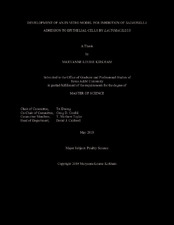| dc.description.abstract | Lactobacillus species are widely used as probiotics because of their health promoting properties and are potentially an important alternative to the sub-therapeutic use of antibiotics in poultry production. Administration of probiotic Lactobacillus cultures to poultry has been demonstrated to improve pre-harvest microbial food safety by reducing gastrointestinal colonization of poultry by human foodborne pathogens. Although competition for adhesion sites on gastrointestinal tissues is thought to contribute to the competitive exclusion of pathogens by Lactobacillus, the mechanisms responsible for this functionality are not well understood. The goal of this study was to develop a series of assays to investigate competitive exclusion of Salmonella by Lactobacillus cultures in vitro using the LMH chicken epithelial cell line. We evaluated the effect of several factors including survival of bacteria in cell culture medium, sequence of bacterial addition to the LMH cell line, co-incubation times, and the number of post-incubation washes needed to remove non-adherent bacteria from the LMH cells. These results were used to develop a set of standardized experimental conditions to evaluate the ability of Lactobacillus cultures to inhibit binding of Salmonella to the chicken LMH cell line. Additionally, by varying the sequence in which probiotic and pathogenic bacteria were added to the chicken LMH cell line, we developed assays to characterize the exclusion (Lactobacillus first), displacement (pathogen first), and competition (simultaneous addition) of pathogens from epithelial cells by Lactobacillus cultures. Exclusion of Salmonella from chicken epithelial cells by Lactobacillus crispatus ST1, Lactobacillus crispatus JCM 5810, Lactobacillus gallinarum JCM 8782, and Lactobacillus gallinarum ATCC 33199 was evaluated. L. crispatus JCM 5810 and L. crispatus ST1 significantly reduced adhesion of Salmonella by 80 and 50 %, respectively.
L. gallinarum ATCC 33199 and L. gallinarum JCM 8782 significantly reduced adhesion ofSalmonella by 70 and 50 %, respectively (P < 0.05). The model we have developed is expected to be applicable to other human foodborne (e.g., Campylobacter) and poultry pathogens (e.g., avian pathogenic E. coli, Clostridium perfringens) and candidate probiotic cultures from other genera (e.g., Bacillus, Bifidobacterium). Further development and validation of this model in live poultry and the use of isogenic adhesion mutants of model Lactobacillus species including L. crispatus and L. gallinarum will contribute to a mechanistic understanding of probiotic functionality in poultry. | en |


